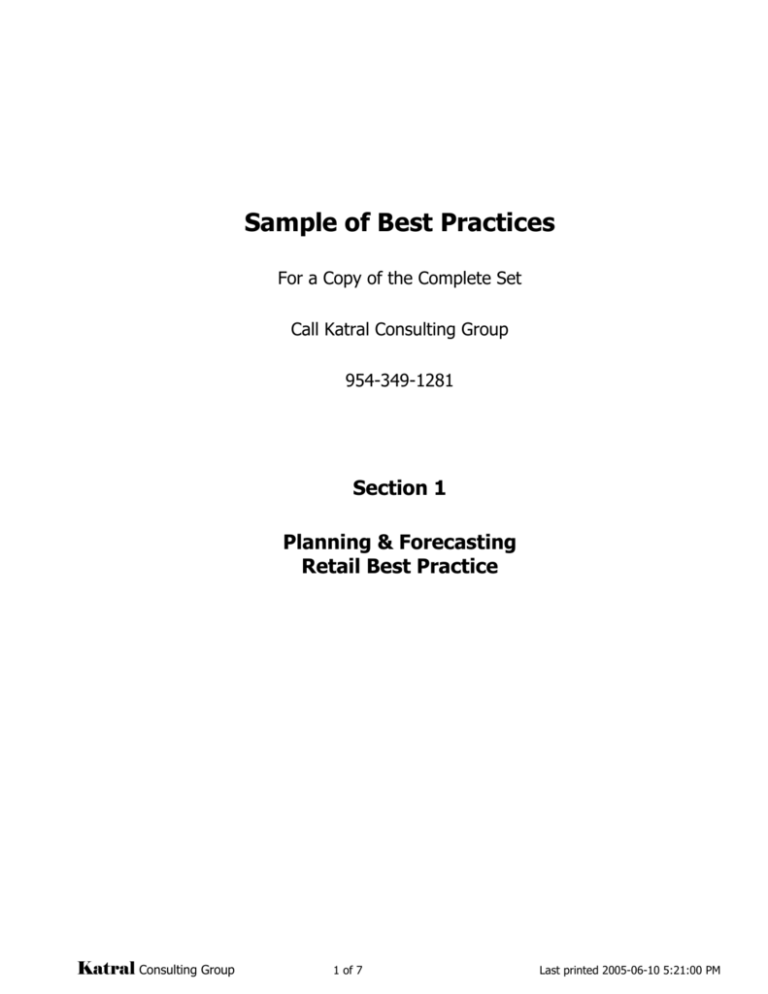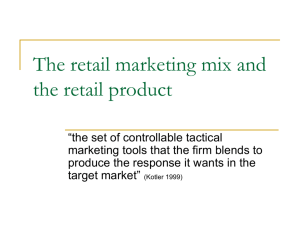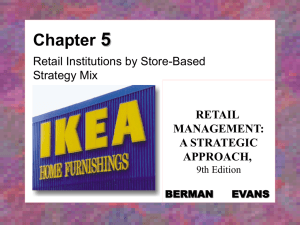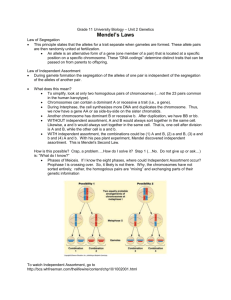Retail Planning and Forecasting Best Practices
advertisement

Sample of Best Practices For a Copy of the Complete Set Call Katral Consulting Group 954-349-1281 Section 1 Planning & Forecasting Retail Best Practice Katral Consulting Group 1 of 7 Last printed 2005-06-10 5:21:00 PM Katral Consulting Group Retail Best Practices – Planning & Forecasting Forecasting Retail Demand Forecasting Method Advanced forecasting software packages forecast sales using statistical algorithms that predict future behavior based on sales history and current performance. The packages will predict demand for an individual item or category at an individual store using several forecasting tools and will select the method that best forecasts demand (“best fit”) or the user can manually select the appropriate forecasting method; i.e. exponential smoothing (giving weight to current history), regression analysis (when there are changes in market conditions), etc. In addition, traditional min/max, sales replacement, and reorder points can be used. Sales history is segmented according to regular demand and irregular demand based on Mean Average Deviation (measures magnitude) and Tracking Signal (measures direction). Forecasts should be based on regular demand unless specified. In addition, adjustments can be made to raw history that adjust for promotional events, one-time events, stock-outs, back orders, effects of promotional repackaging, competitive events, customer data, and other external events. Non-Replenishment Items Although the system will generate recommended seasonal and promotional multipliers based on history, the user may also manually set these parameters. New items can be forecast using history from like-kind items. Each component of the forecast is available for review and adjustment based on reviews. Replenishment Items When approved, the completed forecast is returned to the replenishment tool for conversion into a SOQ (Suggested Order Quantity). Database Internal information requirements include sales and performance history, seasonality, promotions, unplanned events, other data to normalize history, and price points. External information requirements include market trends, market share, competitive prices, weather, and customer demographics. Several services exist to provide companies with external data. These services commonly deal with customer demographics, market share, and competitive trends. A less common example is Strategic Weather Systems, a service that provides long-range weather forecasts. Ability to handle multiple forecast iterations including forecast for financial, merchandise, store and assortment planning and the original annual forecasts with re-forecasting during the year to support changes in planning. Reporting All forecasting reporting is three-dimensional based on merchandise hierarchy, store hierarchy, and time; it supports multiple iterations for finance, merchandise, assortment, store planning and order management. It should include tools to report differences in the forecast iterations. Other ad hoc Katral Consulting Group 2 of 7 Last printed 2005-06-10 5:21:00 PM Katral Consulting Group Retail Best Practices – Planning & Forecasting summaries can be used, such as people-based (GMM, DMM, buyer), private-label vs. brand, color, customer base, other product attributes, or any other logical grouping. • Merchandise Hierarchy – The ability to generate forecast reports at any combination of levels from SKU to department. Also generates forecast on non-hierarchical product characteristics within a hierarchy ... i.e. vendor, size, color, price points, theme, etc. • Store Hierarchy – Includes the ability to report on store brand, store type, store cluster, store grade, market demographics and geographic markets. • Time – Ability to incorporate seasonal indexes, product trends, planned events and seasons; including each seasons’ test period, peak period, and final push period. Forecast reporting periods include quarterly, monthly, and weekly. Ad hoc tools to summarize by responsibilities (GMM, DMM, buyer), private-label vs. brand, color, demographics, other product attributes, or any other logical grouping. Best Practice Retailers The following are samples of other disciples that Retailers have incorporated into their best practices: • Hold “owners” of forecasts accountable for forecast accuracy • Look for ways to systematically improve forecasting process • Communicate forecasts to stakeholders in a timely manner • Devote adequate resources to improving input data sources • Reconcile competing forecasts within the company • Use external factors to improve the accuracy of forecasts. These adjustments for external influences include weather, seasonality of products, competitive promotional activity, and market and competitive trends. Financial & Merchandise Planning Chain-wide merchandise planning translates high-level financial plans into specific financial plans within the merchandising hierarchy. Best practice retailers develop chain-wide plans at the company, division, department, class, and possibly sub-class level. Plans may also be totaled and tracked by GMM, DMM, and buyer or by other relevant reporting levels. Plans are developed at the season, month, and week level in units and dollars, although planning season may need to overlap. 1) Develop Initial Tops/Down Financial Plans. Establish annual financial targets; review and validate strategic direction; develop total chain, division, and department plans; refine projections. 2) Develop Initial Bottoms/Up Merchandise Plans. Using assortment plans and store clusters at the unit level, project sales, receipt flow, inventory, and gross margin plans by class. Roll-up to department, division, and company. 3) Reconcile Financial & Merchandise Plans. Compare the tops/down and bottoms/up plans. Identify and validate any plan variances. Review variance with management and finance, and reconcile plans. Katral Consulting Group 3 of 7 Last printed 2005-06-10 5:21:00 PM Katral Consulting Group Retail Best Practices – Planning & Forecasting 4) Approve Plans. Using the plan developed above, plan additional variables and fine tune unit and dollar plans, revise as needed. Review with management for final approval. 5) Monitor Results. Establish Baseline Merchandise Plan. Review weekly results. Identify potential problems, as well as successes. Revise merchandise plans as needed, leaving the original baseline unchanged. The planning system should support revised plans. Store Planning Store planning is the process of developing plans and analyzing business performance by store, region, and market. Store plans serve as the basis for allocating non-replenished product, particularly seasonal and/or opportunity buys. They should be developed for each store grade and cluster, and location at a division and/or department level. Store plans are planned monthly and/or weekly to support the chainwide merchandise plan and the assortment plan. Plans are reconciled to the chain-wide plan and are used during the budget process. Plans are developed in units and dollars. The merchandise-planning group with store input develops the store plans. 1) Develop Store Targets. Initially, plan at the annual, quarterly and monthly level. Subsequently, break out plans by week. Review targets with store management. 2) Develop Store Department/Division Plans. Develop store divisional plans by month and week, store department plans by month and week, and class/sub-class level store plans by month and week. Review with store management. 3) Identify and Reconcile Plan Variances. Roll up the store department/division plans and compare to the chain-wide department/division plans. Identify and validate any plan variances. Review variance with management and finance, and revise if needed. 4) Revise Store Department/Division Plans. Revise plans, allocate plan variances, roll-up, and submit to management for approval. 5) Monitor Plans Weekly on an Exception Basis. Reforecast the plan, when necessary. Merchandise and Store Plans vs Actual Reporting 1) Establish pre-season/annual budgets that tie to corporate administered topside financial budgets. Inseason/annual, budget numbers are concrete and are not able to be manipulated. 2) The merchandise plans may be revised upon approval at monthly Merchandise Planning Committee (MPC) meetings. The baseline or original merchandise plans are unchanged. Differences in revised plans are included in future reporting and MPC review meetings. 3) Changes in the merchandise plans are set to the financial department for review. Any adverse impact to financial performance may require additional planning and approval by management. Katral Consulting Group 4 of 7 Last printed 2005-06-10 5:21:00 PM Katral Consulting Group Retail Best Practices – Planning & Forecasting 4) Merchandise group has access to weekly performance of actual versus planned. Exception reporting for deviations from planned. Assortment Planning The appropriate merchandise characteristics and attributes are selected for each department’s assortment and planned accordingly. Sample characteristics include fabrication, fashion trend, vendor, price point, color, size and theme. The attribute hierarchy is developed according to these characteristics. It should be based on the level of product substitutability and should be market driven. This hierarchy should provide alternative views, so that the merchandise can be analyzed in various ways. The characteristics listed below are evaluated as to what percentage each should contribute to the department total. You should attain this percentage breakdown within each classification. • Fabrication – What percent will each fabrication contribute? • Fashion Trend-Weight – What percent will each of these factors contribute to each classification? 1) % of Testing Trends, 2) % of Peak Trend, 3) % of Outgoing Trends • Price Point Analysis – What percent will each price point range contribute to each classification? 1) % of Opening price points, 2) % of Mid price points, 3) % of Better price points • Color Balance – What percent will each color range contribute to the classification? How important are basic colors versus fashion colors • Vendor Analysis – What key vendors will be utilized in each classification’s purchases? The core assortment is then planned. This is the baseline assortment to be carried in all stores. The breadth of styles per attribute is planned, as well as the units per style. Typically, the top four styles within each classification should represent 55%-65% of the total classification’s purchases. Assortment plans are created to support variations necessary to address different store clusters made up of store type, store size, store grade, customer demographics and competition. Assortment modules are developed according to store clusters. In a particular module, store attributes are linked to product attributes. A module can add breadth or depth to the core assortment. Many best practice retailers use store input to tailor the specific store assortments. The plan is rolled-up and checked against the Merchandise Plan and Space Allocation Plan. Assortment Planning breaks the merchandise financial plan into units, price points, dollars and specific SKU’s. The plans are typically by week. Assortment plans include the timing of deliveries, as well as exit strategies. Efficient Assortment Planning Build an assortment model based on category stratification, retail data (i.e. sales, profit, sales per square foot, GMROI), market data (i.e. market share per SKU, sales velocity per SKU), and consumer data (i.e. loyalty, exclusivity, consumer worth, substitutability measures). Katral Consulting Group 5 of 7 Last printed 2005-06-10 5:21:00 PM Katral Consulting Group Retail Best Practices – Planning & Forecasting Determine and input target percent of market share into the model for the category segment for SKUs that are core to all of the stores. For example, the retailer might choose to have an 80% market share coverage in a particular category. Determine which SKUs fall below the sales coverage target and screen based on market, retail, and consumer measures to judge propriety of deletion. A particular brand might fall out, due to a low score on brand loyalty. Screen SKUs that fall above the sales coverage target based on market, retail, and consumer measures to judge propriety of retention. A SKU could be eliminated, even if it scored highly, if other factors, such as sales, are very low. For example, although a particular SKU may have scored high on consumer worth, the sales are so minimal that the SKU should not be retained. Review potential SKUs that are not carried by the retailer, but that are predicted to fall above the sales coverage target based on market, retail, and consumer measures to judge propriety of addition. At this step, items not carried by the retailer are analyzed by using marketplace measurements and extrapolating them to the retailer. An item with exceptional market performance could be added. Perhaps the retailer might add a SKU manufactured by new vendor, due to excellent profitability, as well as exclusivity. Analyze the entire assortment using a matrix with brands on one axis and product attributes on the other. Finalize the assortment based on the previous retentions, deletions, and additions. Quantify the impact of the proposed assortment and compare to the current assortment, based on the scores from the retail, market and consumer data. Conduct a profitability analysis to determine projected sales, profit, inventory, inventory turns and GMROI. Store Grading and Clustering Many best practice retailers use the process of Store Grading and Clustering to group their stores according to common characteristics. This is necessary for planning, allocation and replenishment in chains with large quantities of stores, and stores that are diverse. Clustering and Grading allows the retailer to buy for like stores together. Store Grading and Clustering is an ongoing process. Stores must be updated for relocation, remodeling, opening, closing, and changing environments. Store Grading is the process of defining stores group in terms of volume. For example, the highest volume stores are commonly graded AA. A low volume store would be graded a C or D. Store Clustering is the process of defining stores in terms of like attributes. Clusters are commonly based on store size, climate, store type, store location, customer demographics, psychographics and competition. Retailers use long-range weather forecasts from Strategic Weather Services (Wayne, PA) to help determine climate codes and minimize the risks associated with weather. Lost sales can be reduced by 10% to 30% when goods are sent to areas where there are weather opportunities. Katral Consulting Group 6 of 7 Last printed 2005-06-10 5:21:00 PM Katral Consulting Group Retail Best Practices – Planning & Forecasting Micro-Merchandising In general, best practice retailers have a large percentage of merchandise that is considered core (6080%), with 20-40% of the merchandise being tailored to the local store. Micro-Merchandising is an important tool for best practice retailers that have larger percentages of local assortments (30-40%) and that operate in diverse geographic and ethnic areas. Micro-Merchandising works by defining local assortments for meeting specifically needs of the local customers, replenishing on a consistent basis, and allocating the proper amount of floor space. It also works extremely well when supported by a micromarketing effort (i.e. locally or regionally tailored advertising and in-store visuals). Internal information on individual store performance is combined with external customer data, demographic data and psychographic data to provide an “outside-in” purchasing potential approach to planning and attribute development. Merchandise, customer and market information are analyzed together, in order to paint a more complete picture of sales. The combination of this data supports a correlation analysis that identifies performance patterns and emerging trends. Using this analysis, the retailer is able to respond to diversity in store, demographic and regional conditions with precision and maneuverability. Assortments are tailored specifically to local needs based on factual knowledge, and not just instinct on what would sell there. Micro-merchandising also allows for very detailed and precise store clustering. In addition, when combined with effective replenishment, the local assortment needs are supported by the appropriate stock levels that are needed to drive sales and meet local needs. Advanced data warehousing and data mining tools are required to store and manipulate the large amounts of internal and external data required. Customer Research Customer Research is essential for proper Assortment Planning. Also, links to the data warehouse must be maintained for Micro-Merchandising. Knowing your customer is essential to developing the proper assortment for them. Customer Database: The database should include customer demographics, and psychographics. A good source for the database is POS, credit-card, direct mail information, or a company may choose to use a third party resource to compile and maintain the database. Primary Research: The two basic tools for primary research are customized surveys and focus groups. Secondary Research: Secondary research is typically focused around syndicated surveys. Many companies offer information focused around brand data, category data and trends, psychographic and demographic customer clusters, and shopping pattern and trend information. This information can be purchased if it is not cost effective for them to do the research in house. Many trend or fashion sensitive retailers have in-house customer research departments. They do a significant amount of primary research with their catalog customers; some use their customer list to test new catalog ideas. Katral Consulting Group 7 of 7 Last printed 2005-06-10 5:21:00 PM





